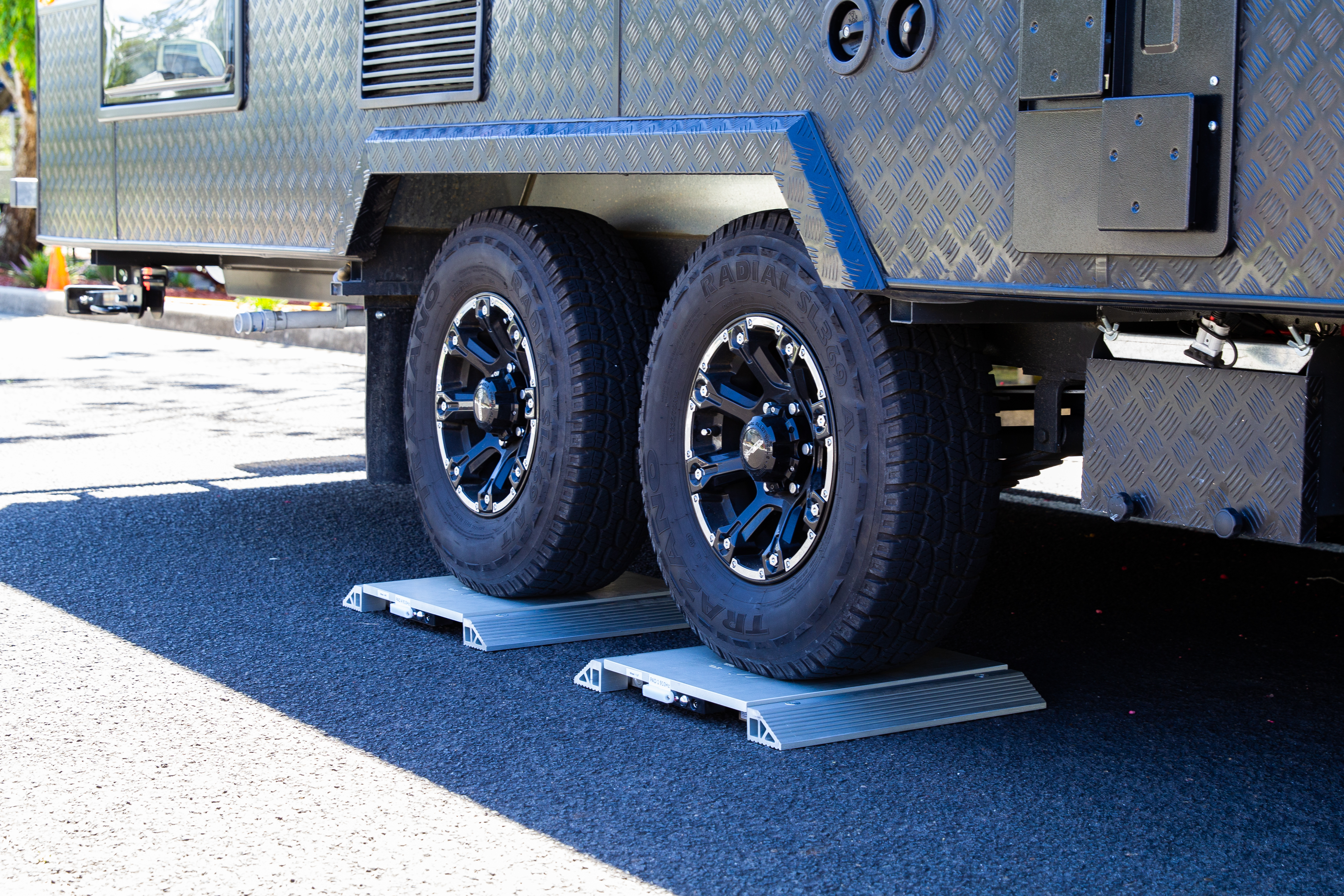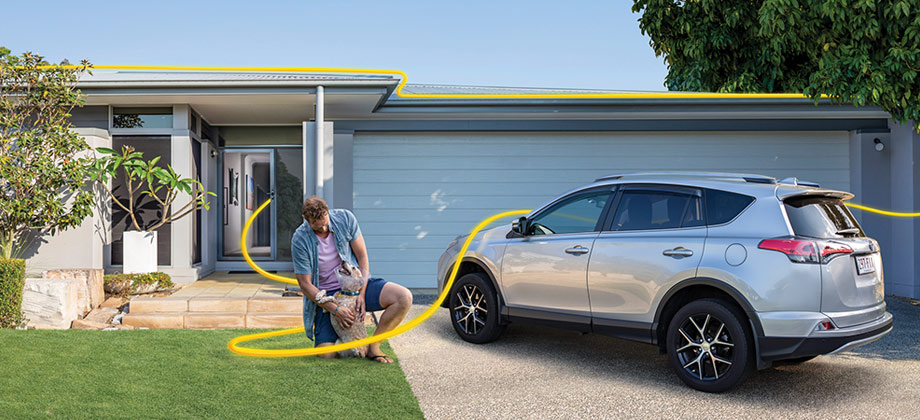How to select a trailer and two vehicle combination
Before you start thinking about buying a heavier trailer such as a caravan, or a vehicle to tow it, you must understand the rules and terminology, and how it applies.
Important: The following information is based on Queensland regulations. Other States and Territories may have slightly different rules.
Rules about what you can tow
Vehicles with a Gross Vehicle Mass (GVM) of less than 4.5 tonnes can tow a trailer with an Aggregate Trailer Mass (ATM) up to:
The lesser of:
- The tow vehicle manufacturer’s recommended maximum towing mass, or,
- The tow vehicle’s towbar rating
When towing capacity is not specified
If the vehicle manufacturer has not specified a towing capacity, Queensland regulations allow the towing of a trailer:
- One and a half times the un-laden mass of the towing vehicle, if the trailer is fitted with brakes, or,
- If the trailer is not fitted with brakes, 750kg Gross Trailer Mass (GTM) or the un-laden mass of the towing vehicle, whichever is the lesser.
Notes:
Factors such as the design and construction of the vehicle and capacity of the towbar may decrease a vehicle’s towing capacity to below these figures. Where no Ball Load information is provided the vehicle’s rear axle load rating and tyre load rating need to be considered. As a general guide, unless otherwise indicated, a Ball Load of 10 per cent of the trailer’s Aggregate Trailer Mass (ATM) should not be exceeded.
Trailer mass terminology explained
The maximum weight of a trailer is specified as either its Aggregate Trailer Mass (ATM) or Gross Trailer Mass (GTM).
ATM is the combined weight of the trailer and its full load when it is not coupled to a tow vehicle.
GTM is the weight of the fully loaded trailer imposed on the trailer’s axle when it is coupled to the tow vehicle. (1)
- Ball Load is the weight the fully laden trailer imposes (vertically) on the tow bar of the tow vehicle.
- Tare Weight is the un-laden weight of the trailer.
- Payload is the trailer’s carrying capacity.
Where to find this information
- All trailers built since August 1989 are required to have a plate listing the trailer’s ATM. (2)
- Some will also show the Tare Weight and the GTM.
- Ball Load is not usually shown on the trailer plate. It must be measured with special ball mass scales, or on a weighbridge by disconnecting the fully laden trailer from the tow vehicle and
- resting only the trailer’s draw bar (via the jockey wheel) on the scales.
Payload is the difference between the Tare Weight and the ATM. (3)
Notes:
GTM will always be less than ATM as some of the trailer weight is transferred to the tow vehicle when the trailer is coupled to it.
Trailers built before August 1989 may not have this plate and you may need to seek the assistance of a trailer dealer or engineer.
Payload is the trailer’s carrying capacity. It is important for all trailers, however it’s critical to campers and caravans, many of which have quite limited carrying capacity to start with. Modifications and additions to the trailer can very quickly reduce its carrying capacity and result in an overloaded trailer, or the inability to legally carry necessary equipment. Things like additional water tanks and gas cylinders can add significant extra weight. As a guide, each additional litre of water carried adds 1kg (excluding the weight of the water tank and necessary fittings) while each full 9kg gas cylinder adds approximately 18kg (plus the weight of the fittings).
Tow vehicle specifications explained
A vehicle's towing capacity is specified to ensure the vehicle is safe and durable. It cannot be increased.
Tow capacity is the maximum weight the vehicle can tow. (i.e. the trailer’s ATM)
- Towing capacity - un-braked, is the maximum weight of the trailer without brakes that can be towed by the vehicle.
- Towing capacity - braked, is the maximum weight of a trailer with brakes that can be towed by the vehicle.
Tow Ball Load is the weight applied (vertically) to the rear of the tow vehicle by the trailer. It will be listed as a weight in kilograms or as a percentage of the trailer’s ATM (4)
Gross Combination Vehicle Mass (where given) is the maximum allowable weight of the trailer, tow vehicle, and the load in the tow vehicle and trailer. It includes the weight of passengers.
Maximum (Rear) Axle Load (where given) is the maximum weight that can be imposed on the rear axle, including the total load carried in the vehicle and the weight imposed by the trailer (the Ball Load).
Where to find this information
Towing specifications are included in the vehicle’s handbook. (5)
Tow bar specifications
Maximum tow bar capacity is the maximum weight the tow bar is rated for. (6)
Tow Ball load is the maximum weight applied (vertically) to the tow ball.
Where to find this information
Tow bars made after 1 July 1988 will have their specifications shown on a plate attached to the tow bar. (7)
Notes:
(4) Ball Load is the actual weight imposed on the rear of the tow vehicle and as such is a function of the trailer’s axle position and the way it is loaded. For this reason, the trailer manufacturer does not usually specify trailer Ball Load. Ball Load specifications are often around 10% of the maximum towing mass specification, however this isn’t always the case – it may be lower or higher. Many European vehicles have quite low allowable Ball Loads in relation to their towing capacity. Too little Ball Load can cause the trailer to become unstable and too much can be detrimental to the tow vehicle’s durability, stability, steering, and braking.
(5) Towing specifications can change from model to model, year to year and even within the same model range. So, it’s vital that you always confirm that the information obtained is applicable to the particular vehicle. If you have any doubt about the accuracy of the information, we recommend confirming it with the vehicle’s manufacturer.
(6) It is common to find tow bar specifications that differ from those given for the vehicle. This usually occurs where the bar is made for several different models in the range, or where light and heavy-duty tow bars are offered for the vehicle.
(7) When dealing with older unmarked tow bars, it can be difficult to determine the bar’s capacity. In this case, we suggest you discuss the matter with a reputable tow bar manufacturer who may be able to provide professional advice about its suitability for the application.
Using this information to select a trailer / tow vehicle
- The towing vehicle must have sufficient capacity in all respects to tow the fully laden trailer.
- The vehicle’s specifications will always be the maximum the vehicle can legally tow, even if the tow bar is rated for a higher load.
- However, if any of the tow bar specifications are lower than those given for the vehicle, the tow bar’s specification will override the vehicle’s specifications.
- Ball Load specifications and, where given, Axle Loads, and Gross Combination Vehicle Mass must not be exceeded.
- The trailer must always be safely controllable by the towing vehicle.
Caution:
- While some vehicle manufacturers provide clear and unambiguous information about towing capacities, this is not the case for all.
- Where the vehicle is capable of carrying a load (such as a utility), the manufacturer may impose sometimes very complex additional stipulations that can reduce its towing capacity, the load it can carry or its ball load.
- Do not ignore such specifications as they can have a huge impact on the weight that can legally towed or carried.
Other considerations
Vehicle durability
- A light duty vehicle, such as a passenger car, may be satisfactory for occasional towing, but if you’re planning to do a lot of heavy or long distance towing it’s probably worth considering something a bit more robust.
- But while a big 4WD for instance may be a good choice if you plan to do a lot of towing, it could be a bad choice if your driving is mostly around town. Increased size, difficulty in parking, high fuel consumption and costlier maintenance need to be considered.
Allow a margin of reserve
- Some experienced caravanners suggest that to ensure long-term durability, the maximum trailer weight should not be more than about 70 percent of the vehicle’s maximum tow capacity.
- But in some cases, this margin may not be achievable simply because few common tow vehicles have more than about 3.5t towing capacity.
Matching the vehicle to the towing requirements
- Just because a vehicle has sufficient towing capacity for the application, don’t automatically assume that it will be a capable or durable tow vehicle.
- Quite simply, some vehicles will be better at the job than others. There is no easy answer to this - the best advice we can offer is to talk to the people who already own and tow with the vehicle you’re considering.
Speed restrictions
- Some vehicle manufacturers impose speed restrictions when towing above certain weights.
- This typically means that the vehicle is restricted to a maximum speed of approximately 80km/h.
- This could be an important factor, particularly if you’re planning to tow long distances.
Trailer information, design rules and legalities
Vehicle Standards Bulletin 1 is the 'rule book' for Australian light trailers. It contains a plain English explanation of the information you need to know about light trailer dimensions, lighting, brakes and much more.
Things to note
The information in this article has been prepared for general information purposes only and is not intended as legal advice or specific advice to any particular person. Any advice contained in the document is general advice, not intended as legal advice or professional advice and does not take into account any person’s particular circumstances. Before acting on anything based on this advice you should consider its appropriateness to you, having regard to your objectives and needs.

